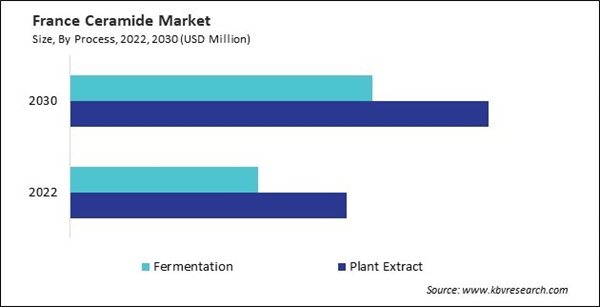In recent years, the utilization of ceramides in food products has gained attention due to their potential health benefits, particularly in promoting skin health and overall well-being. These are lipid molecules naturally found in the skin, but they can also be sourced from dietary sources such as wheat germ, rice bran, and soybeans. Incorporating into food products offers a convenient way to support skin hydration, elasticity, and barrier function from within. Therefore, the Germany market utilized 7.06 tonnes of Ceramide in food products in 2022.
The Germany market dominated the Europe Ceramide Market, By Country in 2022, and would continue to be a dominant market till 2030; thereby, achieving a market value of $8,613.6 Thousands by 2030. The UK market is exhibiting a CAGR of 4% during (2023 - 2030). Additionally, The France market would experience a CAGR of 5.7% during (2023 - 2030).
Liposomal encapsulation involves entrapping it within lipid vesicles called liposomes, which mimic the structure of cell membranes. Liposomes act as carriers, facilitating the transport of ceramides across the skin barrier and enhancing their penetration into the epidermis and dermis. This delivery system protects ceramides from degradation and oxidation, prolonging their stability and bioavailability within skincare formulations.
Likewise, nano-emulsions consist of tiny droplets of its oil dispersed in water, resulting in a stable and homogeneous formulation with enhanced skin penetration properties. The small particle size of nano-emulsions allows deeper penetration into the skin, reaching the underlying layers where it exerts their therapeutic effects. Nano-emulsions offer advantages such as improved spreadability, faster absorption, and a non-greasy feel compared to traditional emulsions, enhancing the user experience of ceramide-based skincare products.
According to the International Trade Administration data, Belgium’s pharmaceutical industry spends $1.64 billion (€1.5 billion) on R&D every year, equivalent to 40 percent of all private investment in Belgium. As a result, Belgium is home to 29 of the world’s top 30 pharmaceutical companies, including important subsidiaries of major U.S. companies such as Johnson and Johnson and Pfizer. Hence, the growing pharmaceutical sector and increasing disposable income in Europe will drive the demand for ceramides in the region.
Based on Application, the market is segmented into Cosmetics, Food, and Others. Based on Process, the market is segmented into Plant Extract, and Fermentation. Based on Type, the market is segmented into Natural, and Synthetic. Based on countries, the market is segmented into Germany, UK, France, Russia, Spain, Italy, and Rest of Europe.
List of Key Companies Profiled
- Ashland Inc.
- Toyobo Co., Ltd.
- Doosan Corporation
- Arkema S.A.
- Evonik Industries AG (RAG-Stiftung)
- Cayman Chemical Company, Inc.
- Kao Corporation
- Croda International PLC
- Vantage Specialty Chemicals (H.I.G. Capital, LLC)
- Incospam Co., Ltd.
Market Report Segmentation
By Application (Volume, Tonnes, USD Million, 2019-2030)- Cosmetics
- Food
- Others
- Plant Extract
- Fermentation
- Natural
- Synthetic
- Germany
- UK
- France
- Russia
- Spain
- Italy
- Rest of Europe
Table of Contents
Companies Mentioned
- Ashland Inc.
- Toyobo Co., Ltd.
- Doosan Corporation
- Arkema S.A.
- Evonik Industries AG (RAG-Stiftung)
- Cayman Chemical Company, Inc.
- Kao Corporation
- Croda International PLC
- Vantage Specialty Chemicals (H.I.G. Capital, LLC)
- Incospam Co., Ltd.









